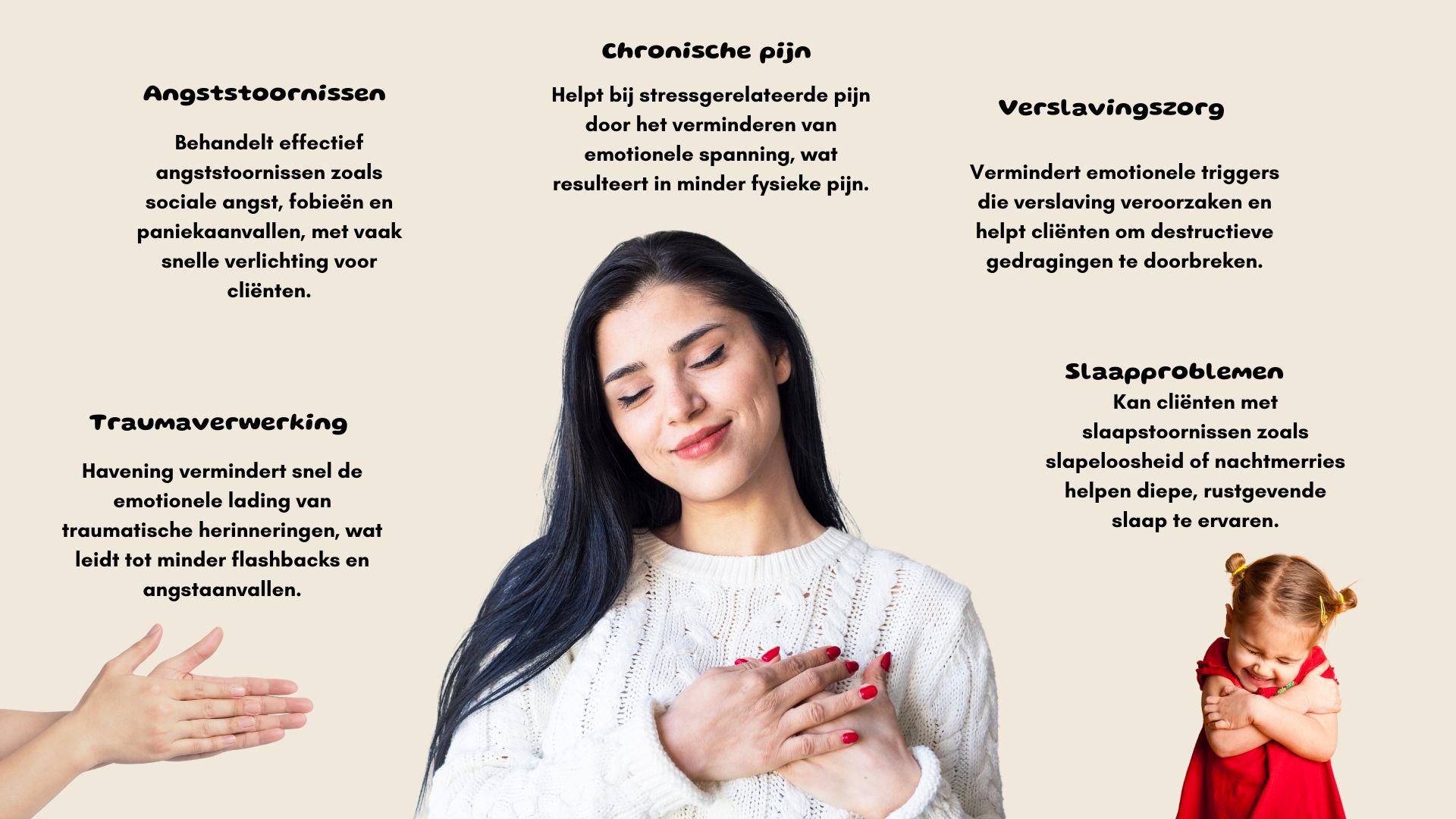Havening Techniques: Een baanbrekende methode
Havening Techniques is een baanbrekende methode, gebaseerd op neurowetenschappelijke inzichten. Therapeuten helpen cliënten hiermee om snel trauma, angst en stress te verminderen. Deze techniek biedt professionals een effectieve manier om blijvende resultaten te bereiken.
Wat zijn Havening Techniques®?
Havening Techniques® is een therapievorm die negatieve effecten van trauma en stress vermindert. Het woord ‘Havening’ komt van het Engelse ‘haven’, wat schuilplaats betekent. Deze methode creëert een veilige mentale ruimte voor cliënten, zodat ze emoties kunnen loskoppelen van vervelende herinneringen. Met Havening Touch® kalmeren zachte aanrakingen het emotionele brein, vooral de amygdala. Dit vermindert binnen enkele minuten angst en stress.
Hoe werken Havening Techniques?
Havening is gebaseerd op neurowetenschappelijke inzichten. Trauma’s worden in de amygdala vastgelegd, die verantwoordelijk is voor emotionele reacties. Trauma-herinneringen kunnen emotionele en fysieke reacties oproepen, zelfs jaren later.
Havening Touch® combineert aanraking en visualisatie om deze reacties te ontkoppelen. Dit verlaagt de emotionele lading van de herinnering.
Het Havening Techniques-protocol:
- Identificeer de traumatische gebeurtenis.
- Toepassing van Havening Touch® op gezicht, armen en handen.
- Gebruik visualisatie om de emotionele lading te verminderen.
De wetenschap achter Havening Techniques®
Dr. Ronald Ruden ontwikkelde Havening op basis van neurowetenschappelijke ontdekkingen. Trauma wordt opgeslagen in de amygdala. Dit kan langdurige negatieve emoties veroorzaken.
Zachte aanraking kalmeert de amygdala en vermindert de coderingen van trauma. Onderzoek toont aan dat aanraking neurotransmitters zoals serotonine en oxytocine vrijmaakt. Deze verminderen stress en zorgen voor een veilig gevoel.
Toepassingen van Havening Techniques® voor therapeuten
Havening is veelzijdig en effectief bij psychologische en fysieke problemen. Hier zijn enkele belangrijke toepassingen:
1. Traumaverwerking
Havening is een krachtige techniek voor het verwerken van trauma’s en helpt om de emotionele lading van traumatische herinneringen aanzienlijk te verminderen. Door het activeren van specifieke sensorische stimuli, zoals zachte aanrakingen, wordt de neurologische respons van het lichaam hergeprogrammeerd.
2. Angststoornissen
Havening wordt steeds meer erkend als een effectieve benadering voor de behandeling van diverse angststoornissen, waaronder sociale angst, fobieën en paniekaanvallen.
3. Chronische pijn
Chronische pijn heeft vaak niet alleen een fysieke, maar ook een sterke emotionele component. Havening helpt cliënten om de emotionele stress die hun fysieke pijn verergert, los te laten.
4. Verslavingszorg
In de verslavingszorg kan Havening worden ingezet om de emotionele triggers te verminderen die vaak ten grondslag liggen aan verslavend gedrag.
5. Slaapproblemen
Havening helpt cliënten om de emotionele spanning die hun slaap verstoort, los te laten.
Het belang van aanraking in therapie met Havening Techniques
Aanraking is essentieel in Havening. Havening Touch® gebruikt zachte aanrakingen op gezicht, armen en handen. Deze aanraking activeert huidreceptoren en kalmeert de hersenen. Neurotransmitters zoals serotonine en oxytocine worden vrijgemaakt, wat stress vermindert en veiligheid biedt.
Training en certificering: Word een gecertificeerd Havening Techniques Practitioner
Therapeuten kunnen leren om Havening effectief toe te passen. Hiervoor moeten ze een erkende training volgen. In de training leren ze de wetenschap en praktijk van Havening.
Stappen naar certificering:
- Volg een training bij een gecertificeerde Havening Techniques® Trainer.
- Oefen de technieken onder supervisie.
- Word gecertificeerd en sluit je aan bij de internationale gemeenschap van Havening Practitioners.
Testimonials van professionals over Havening Techniques®
“Ik had het geluk om te trainen met Stephen. De training was van hoge kwaliteit. Stephen is enorm deskundig.”
– Eileen Flynn, Docent Psychologie en Sociologie
“Havening als therapie blies me omver. Niets dat ik ooit heb gezien of ervaren komt in de buurt. Als je twijfelt over het volgen van de cursus, denk dan niet te lang na, doe het gewoon. Het zal je leven veranderen. Zeer aanbevolen.”
– Brian Kennedy, Hypnotherapeut
“Stephen is een uitstekende leraar. Ik heb 18 jaar ervaring en niets is krachtiger dan Havening.”
– Archie Coogan, Complementair Therapeut
“In vijfentwintig jaar praktijk heeft Havening mijn leven en werk positief veranderd. De resultaten zijn snel en blijvend.”
– Charlie Briggs, Klinisch Psychotherapeut
Veelgestelde vragen (FAQ) over Havening Techniques®
Wat maakt Havening anders?
Havening biedt vaak snelle en blijvende resultaten, soms binnen één sessie. Dit onderscheidt het van andere therapieën zoals cognitieve gedragstherapie of EMDR.
Is Havening veilig?
Ja, Havening is veilig en niet-invasief. Het gebruik van zachte aanraking maakt het geschikt voor zowel volwassenen als kinderen.
Moet ik een vooropleiding hebben om Havening te leren?
Nee, een specifieke vooropleiding is niet nodig. De training is geschikt voor alle professionals in de geestelijke gezondheidszorg.
Kan Havening online worden toegepast?
Ja, Havening kan online worden toegepast via bijvoorbeeld Zoom, wat het toegankelijk maakt voor therapeuten en cliënten wereldwijd.



